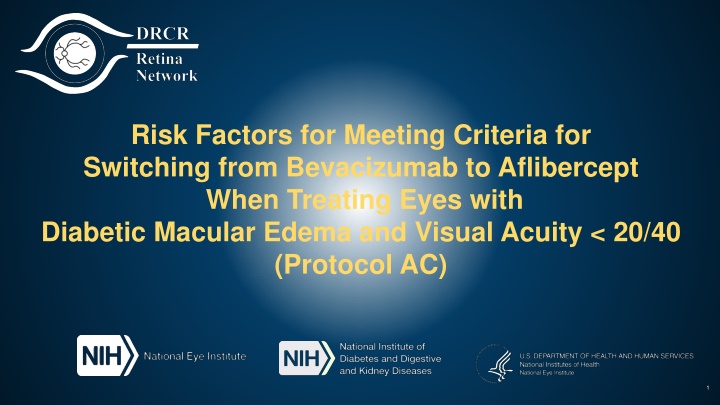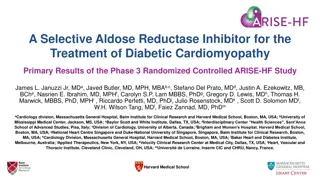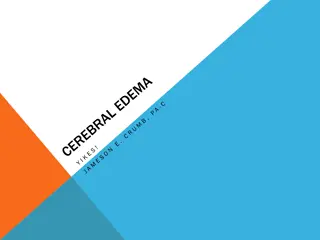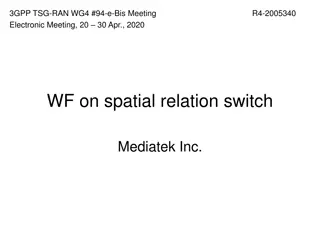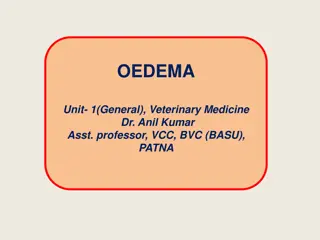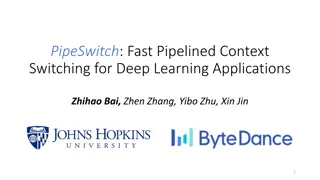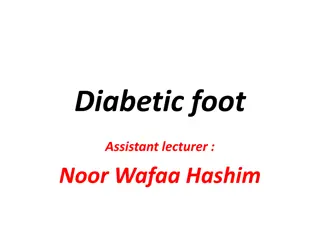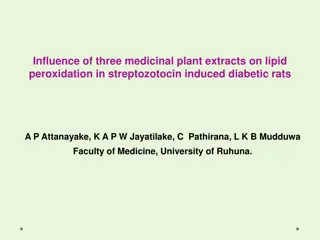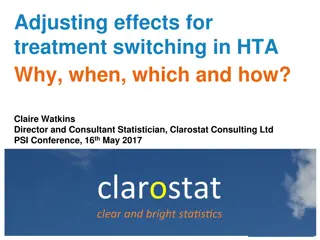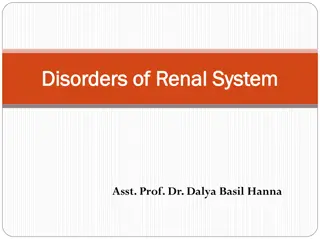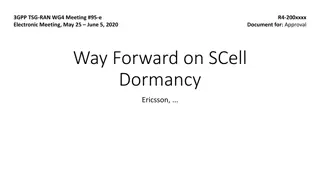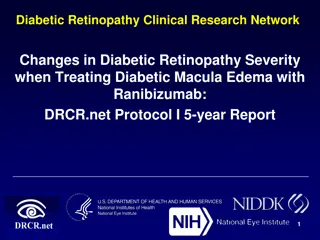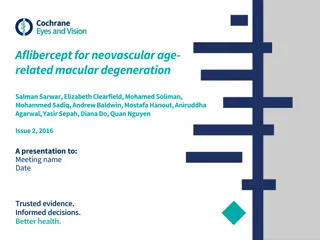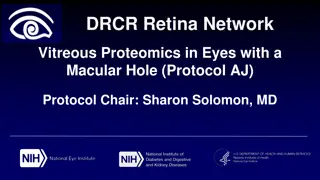Risk Factors for Switching Treatment in Diabetic Macular Edema
The study investigates risk factors influencing the criteria for switching from bevacizumab to aflibercept in treating eyes with diabetic macular edema and visual acuity
Download Presentation

Please find below an Image/Link to download the presentation.
The content on the website is provided AS IS for your information and personal use only. It may not be sold, licensed, or shared on other websites without obtaining consent from the author.If you encounter any issues during the download, it is possible that the publisher has removed the file from their server.
You are allowed to download the files provided on this website for personal or commercial use, subject to the condition that they are used lawfully. All files are the property of their respective owners.
The content on the website is provided AS IS for your information and personal use only. It may not be sold, licensed, or shared on other websites without obtaining consent from the author.
E N D
Presentation Transcript
Risk Factors for Meeting Criteria for Switching from Bevacizumab to Aflibercept When Treating Eyes with Diabetic Macular Edema and Visual Acuity < 20/40 (Protocol AC) 1
Background Time From Randomization to Meeting the Switching Criteria 70% 60% 39% 30% 26% 13% 11% 2% No. at Risk 158 152 139 108 35 154 147 107 59 13 2
Switching Criteria Switch to aflibercept if ALLcriteria are met at 12 weeks: Persistent CI-DME; CST greater than sex and device specific thresholds* Eye has not recently improved VA letter score not improved by 5 over the last 2 visits CST not improved by 10% over the last 2 visits Injection with bevacizumab given at the last two visits Vision is suboptimal Before 24 weeks: ~20/50 or worse ( 68 letters) 24 weeks and later: 20/32 or worse ( 78 letters) Eyes meeting the switch criteria received 2 initial monthly injections of aflibercept, then continued with aflibercept injections throughout study according to the protocol retreatment regimen. 3 * For Zeiss Cirrus, 290 m for females and 305 m for males. For Heidelberg Spectralis, 305 m for females and 320 m for males
Objectives To identify factors for meeting prespecified criteria for switching from bevacizumab to aflibercept in eyes with CI- DME and moderate vision loss. Outcomes: Switching at any time during follow-up (time-to-event) Switching at 12 weeks (for 12-week completers only) Switching after 12 weeks (time-to-event) Methods: Univariable and multivariable Cox regression or logistic regression Stepwise procedures for variable selection to create final multivariable models 5
Meeting the Criteria for Switching at Any Time (Bevacizumab First Group Only) 6
17 Baseline Factors Evaluated* Ocular History or Exam OCT (Reading Center) Central subfield thickness Fundus Photo (Reading Center) Demographics Age Visual acuity DRSS score Race/ethnicity Prior treatment for DME (any) Hard exudates within 6 mm zone Retinal volume** Hemoglobin A1c** Subretinal fluid in central 1 mm Epiretinal membrane within the center 1 mm Intraocular pressure Sex Lens status Duration of diabetes Number of study eyes Smoking status DME: Diabetic macular edema; DRSS: Diabetic Retinopathy Severity Scale * Continuous risk factors were categorized by tertiles for presentation and were modeled as continuous variables in the analyses. ** Not included in the multivariable analyses due to >5% data missing 7
Switching at Any Time Univariable Analysis Hazard Ratio (95% CI) P K-M Baseline Factor Subgroup N Estimate 62% 75% 73% 70% 65% 74% 55% 76% 77% Value 283 428 429 593 610 1002 20/50 20/63 20/80 20/80 20/320 31 56 57 65 66 87 51 52 51 49 54 51 52 54 48 Per 10- m greater 1.01 (1.00, 1.02) Central subfield thickness, m .24 Per 5-letter lower 1.09 (1.01, 1.17) Visual acuity, letter score .03 Per 10-yr greater 1.32 (1.11, 1.58) .002 Age, yr 8 Risk factors of a priori interest (i.e., VA and CST) are shown irrespective of univariable P values.
Switching at Any Time Final Model from Multivariable Analysis P Value Baseline Factor Hazard Ratio (95% CI) Per 10-yr greater 1.32 (1.11, 1.58) .002 Age, yr 9
Switching at Any Time By Baseline Age 77% 76% 55% No. at Risk 52 54 48 49 52 46 39 36 32 28 16 15 5 3 5 10
Meeting the Criteria for Switching at 12 Weeks (Bevacizumab First Group Only) 11
Switching at 12 Weeks* Univariable Analysis P value Baseline Factor Subgroup N Proportion Odds Ratio (95% CI) 283 428 429 593 610 1002 20/50 20/63 20/80 20/80 20/320 34 56 57 65 66 87 48 48 47 47 51 45 46 52 45 6% 13% 15% 0% 14% 20% 11% 8% 16% Per 10- m greater 1.02 (0.98, 1.05) Central subfield thickness, m .35 Per 5-letter lower 1.30 (1.03, 1.63) Visual acuity, letter score .03 Per 10-yr greater 1.36 (0.75, 2.47) .31 Age, yr Reference 4.84 (1.32, 17.81) Female Male 70 73 4% 18% .02 Sex * 12-Week completers only. Risk factors of a priori interest (i.e., VA and CST) are shown irrespective of univariable P values. Multivariable analysis was not performed since only 16 eyes switched treatment at 12 weeks. 12
Meeting the Criteria for Switching after 12 Weeks (Bevacizumab First Group Only) 13
Baseline and 12-Week Factors Evaluated* Ocular History or Exam OCT (Reading Center) Central subfield thickness Fundus Photo (Reading Center) Demographics Age Visual acuity DRSS score Race/ethnicity Prior treatment for DME (any) Hard exudates within 6 mm zone Retinal volume** Hemoglobin A1c** Subretinal fluid in central 1 mm Epiretinal membrane within the center 1 mm Intraocular pressure Sex Lens status Duration of diabetes Number of study eyes Smoking status 12-Week central subfield thickness Change in central subfield thickness from baseline at 12 Weeks Change in retinal volume from baseline at 12 Weeks** 12-Week visual acuity Change in visual acuity from baseline at 12 Weeks DME: Diabetic macular edema; DRSS: Diabetic Retinopathy Severity Scale * Continuous risk factors were categorized by tertiles for presentation and were modeled as continuous variables in the analyses. ** Not included in the multivariable analyses due to >5% data missing. 14
Switching after 12 Weeks* Univariable Analysis Hazard Ratio (95% CI) P Baseline Factor Subgroup N K-M Estimate value 283 428 429 593 610 1002 20/50 20/63 20/80 20/80 20/320 31 56 57 65 66 87 48 46 44 49 47 42 47 50 41 59% 71% 68% 70% 59% 68% 50% 74% 73% Per 10- m greater 1.01 (0.99, 1.02) .36 Baseline CST, m Per 5-letter lower 1.06 (0.97, 1.16) Baseline VA, letter score .20 Per 10-yr greater 1.32 (1.10, 1.59) .003 Age, yr Reference 0.66 (0.43, 1.00) Female Male 71 67 74% 57% .05 Sex * Excluding eyes switched at 12 weeks. Risk factors of a priori interest (i.e., VA and CST) are shown irrespective of univariable P values. CST = central subfield thickness; VA = visual acuity. 15
Switching after 12 Weeks* Univariable Analysis Hazard Ratio (95% CI) P 12-Week Factor Subgroup N K-M Estimate value 211 342 343 426 428 844 20/16 20/32 20/32 20/50 20/50 <20/800 -632 to -141 -140 to -47 -45 to 163 -51 to 7 8 to 14 15 to 38 45 42 40 52 43 32 41 45 41 39 40 48 35% 76% 92% 52% 76% 75% 46% 63% 89% 85% 70% 49% Per 10- m greater 1.06 (1.04, 1.07) <.001 12-Week CST, m Per 5-letter lower 1.11 (1.04, 1.17) 12-Week VA, letter score <.001 Per 10- m increase 1.04 (1.02, 1.06) Change in CST from baseline, m <.001 Change in VA from baseline, letter score Per 5-letter decrease 1.11 (1.03, 1.20) .006 * Excluding eyes switched at 12 weeks CST = central subfield thickness; VA = visual acuity. 16
Switching after 12 Weeks* Final Model from Multivariable Analysis P Value Factor Adjusted Hazard Ratio (95% CI) Per 10- m greater 1.06 (1.04, 1.07) <.001 12-Week CST, m 17 CST = central subfield thickness.
Switching after 12 Weeks* By 12-week CST 92% 76% 35% No. at Risk * Excluding eyes switched at 12 weeks 45 41 40 42 33 28 32 19 5 7 2 3 CST = central subfield thickness 18
Analysis of Aflibercept Monotherapy Group* 19 * Applying the similar criteria for switching to eyes in the aflibercept group. Eyes did not switch treatment during follow-up.
Meeting the Criteria for Switching at Any Time Multivariable Analysis P Value Baseline Factor Adjusted Hazard Ratio (95% CI) Per 10-yr greater 1.61 (1.26, 2.06) <.001 Age, yr Per 10- m greater 1.03 (1.01, 1.04) .001 Baseline CST, m Epiretinal membrane on baseline OCT within the center 1 mm Present vs. Absent 2.42 (1.34, 4.38) .003 20 ERM = epiretinal membrane; CST = central subfield thickness.
Meeting the Criteria for Switching after 12 Weeks* Multivariable Analysis P Value Baseline Factor Adjusted Hazard Ratio (95% CI) PC IOL vs. Phakic 3.14 (1.57, 6.26) .001 Baseline Lens Status Per 10- m greater 1.10 (1.06, 1.13) <.001 12-Week CST, m Per 5-letter lower 1.15 (1.05, 1.26) .002 12-Week VA, letter score * Excluding eyes switched at 12 weeks PC IOL = posterior chamber intraocular lens; CST = central subfield thickness; VA = visual acuity. 21
Summary A higher risk of switching at any time over 2 years was associated with older baseline age. At 12 weeks, eyes with worse baseline vision and male participants had a higher risk of meeting switching requirements. After 12 weeks, thicker CST at 12 weeks was found to be the only risk factor for meeting the switch criteria. 22
Summary In the aflibercept monotherapy group, Patients with older age, worse CST, and ERM at baseline were more likely to meet the similar switching criteria at any time during follow-up. After 12 weeks, patients with PC IOL at baseline, or worse CST and VA at 12 weeks showed a higher risk for meeting the criteria in the future. 23
Discussion The risk factors identified here can be used to refine expectations regarding switching to aflibercept when treatment is initiated with bevacizumab. At baseline, older patients are more likely to switch. As would be expected, greater CST at 12 weeks was predictive of who is most likely to switch in the future, after the 12-week visit. These risk factors can be used to enhance counseling for patients who are initiating therapy for DME with bevacizumab. 24
